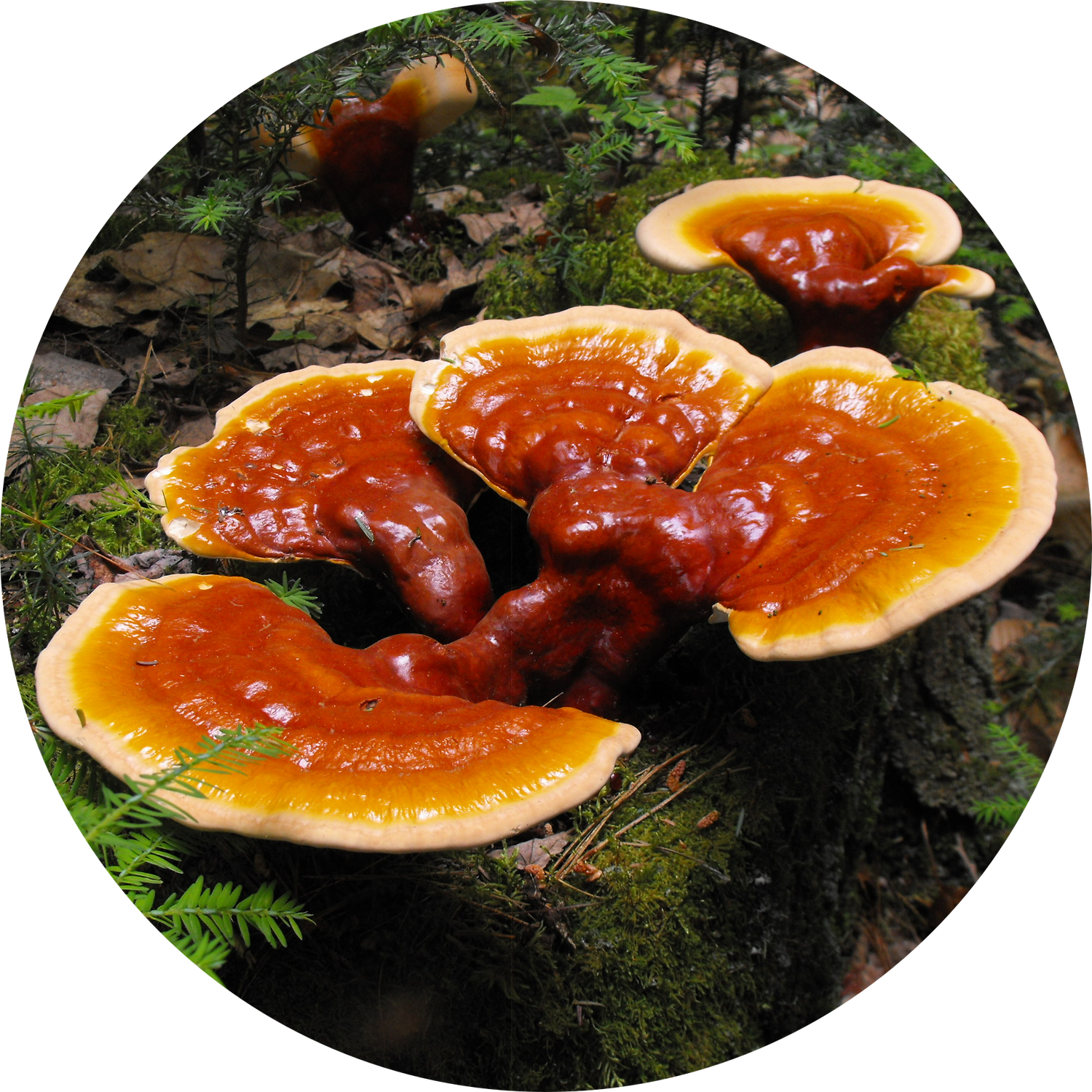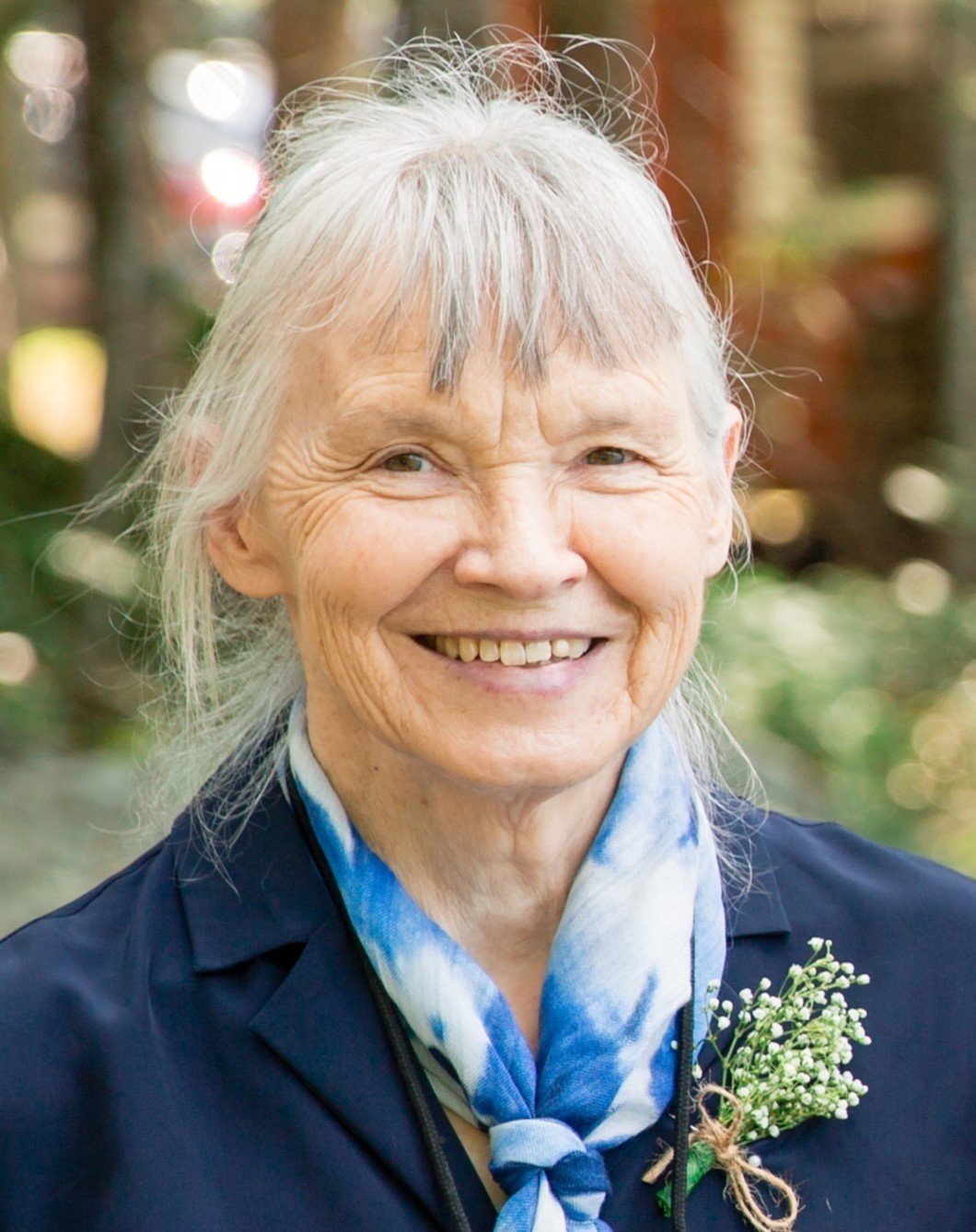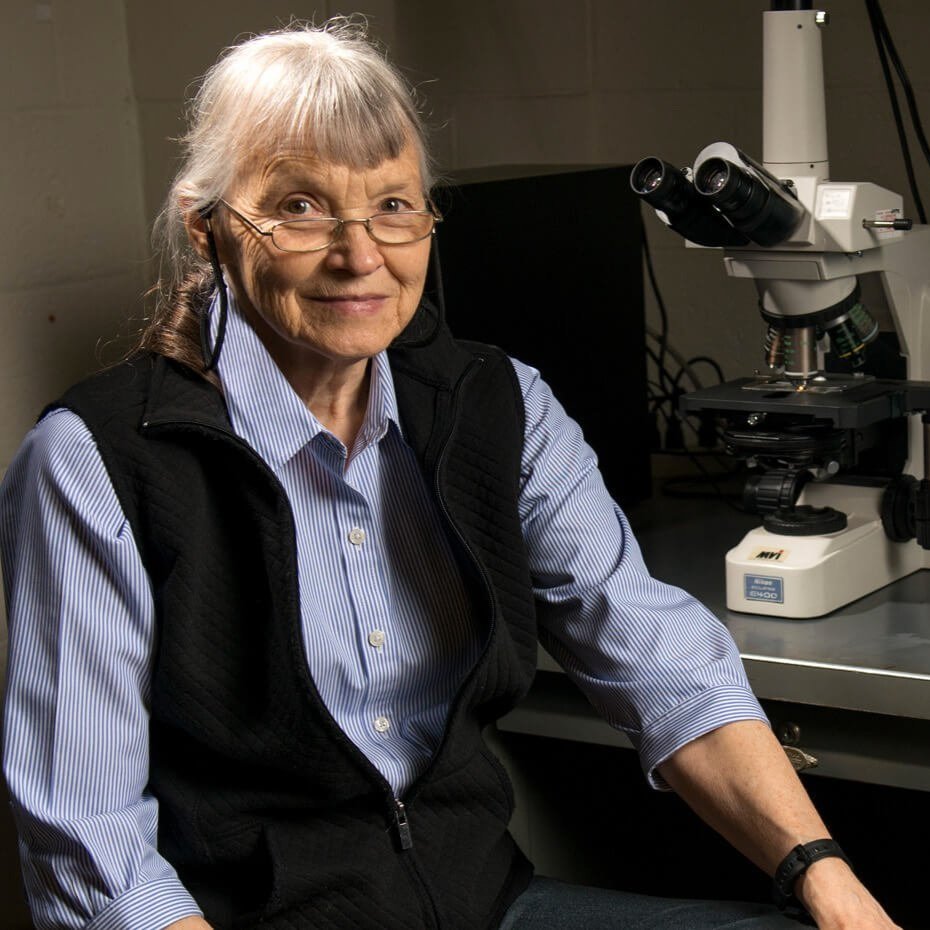
Joyce E. Longcore
You never know when something that is found will become important
An expert with deep rhizoids
Originally prepared for the Collection of Zoosporic Eufungi at the University of Michigan:
Joyce Longcore was born in South Haven, MI. She received a B.S. in Biology from the University of Michigan in 1960, after which she worked for a postgraduate year for Dr. Frederick K. Sparrow, Jr., the renowned author of Aquatic Phycomycetes (1st ed. 1943, 2nd ed. 1960), the singular monographic work that includes what we now call the Chytridiomycota and Blastocladiomycota. Sparrow was a Professor of Botany at the University of Michigan from 1936 to 1972, additionally serving as Director or Acting Director of the University of Michigan Biological Station from 1967 to 1971.
Longcore continued her education at Indiana University, receiving an M.A. in 1963 under the tutelage of Dr. Robert Johns, a former Ph.D. student of Sparrow, before returning to the University of Michigan to work for Sparrow. After marriage in 1964, Longcore moved to Maryland, but continued to work for Sparrow in the laboratory of Dr. Robert A. Paterson, another former student of Sparrow, who at the time taught at the University of Maryland. For 20 years, Longcore identified as a “full-time housewife and mother”, moving to Orono, Maine in 1976. In 1984, Longcore began graduate school at the University of Maine, with Dr. Richard Homola, a Basidiomycota specialist and former graduate student of Dr. Alexander Smith, serving as her graduate adviser. Sparrow had passed away in 1977, and few other investigators were continuing to examine chytrid and blastoclad fungi. Longcore combed the literature for systematic work published since the second edition of Aquatic Phycomycetes and learned how others were isolating chytrids into pure culture. Although she started out by comparing the zoosporic fungi in two adjacent lakes in Hancock Co., Maine, she soon found new fungal species for which she needed to generate descriptions. In the 1980s, zoospore ultrastructure had become a key line of evidence for new taxonomic groupings of chytrid fungi, and Dr. Donald J. S. Barr hosted Longcore in his Agriculture Canada laboratory in Ottawa to learn electron microscopy techniques for chytrids. In 1991, Longcore received a Ph.D. from the University of Maine. In her dissertation, she described 3 new species using observations made by light and electron microscopy, including the new genus Lacustromyces, and the species Chytriomyces angularis, which would later become the type specimen of the order Lobulomycetales.
Since earning her Ph.D., Longcore has maintained a modest laboratory at the University of Maine, has had four graduate students, and is currently an Associate Research Professor in the School of Biology & Ecology. She has focused on culturing a diverse assemblage of zoosporic eufungi, and in that process developed an extensive collection of chytrids and blastoclads (the “JEL” collection) over the last 30 years. Longcore began a collaboration with Dr. Timothy Y. James (Curator of CZEUM) when he was a Ph.D. student at Duke University in the laboratory of Dr. Rytas Vilgalys. In 2000, James published the first comprehensive molecular phylogeny of chytrid fungi, including a large number of JEL cultures. Molecular phylogenetics, along with the discovery of the amphibian pathogen Batrachochytrium dendrobatidis and its isolation and culturing by Longcore, spurred a revitalization of systematic work on chytrid fungi. Over the years, Longcore has isolated nearly 1000 cultures, and of these, over 600 are still available, including 127 isolates of Batrachochytrium dendrobatidis. Separate from the cultures with JEL designations, Longcore also maintained 115 isolates of Batrachochytrium dendrobatidis from collaborative studies, making the total JEL collection (which was the founding material of the CZEUM collection) one of the largest living collections of this pathogen. In 2017, Longcore received the Golden Goose Award from the National Academy of Sciences for her ground breaking work on B. dendrobatidis, which was rooted in her painstaking work on chytrid biodiversity and discovery.
In 2018, Longcore wished to ensure a more permanent, cryopreserved residency for the JEL collection at the University of Michigan, where James was now an Associate Professor and Associate Curator of Fungi. Until that time, Longcore maintained cultures either on agar slants or in vials of liquid media that she transferred quarterly, or via cryopreservation in liquid nitrogen Dewars. The former method required intensive efforts in preparation, transferring, observation, and maintenance, whereas the latter was less time-consuming, but required weekly, manual additions of liquid nitrogen to maintain cryopreservation. At the University of Michigan Research Museums Center, the University of Michigan Herbarium (MICH) cryopreservation unit contains automated liquid nitrogen freezers, allowing for near-permanent storage of cryopreserved tissues. Dr. D. Rabern Simmons, graduate student of Longcore and then postdoctoral researcher for James, facilitated the safe, cryopreserved transfer of Longcore’s specimens, and constructed the collection database from Longcore’s previous iteration, including information from her personal logs.
October 13th is International Batrachochytrium Isolation Day
Originally published in Inoculum 2023, Issue 3
Sunday, October 12, 1997: Joyce Longcore comes into the microscopy lab like so many days before. She’s been staring at pieces of frog skin under the microscope for weeks, but she can’t wait until Monday to continue her isolation attempts. For hours on end, she has examined the mysterious iridescent circles, their chitin cell walls shimmering under brightfield microscopy, pockmarking the polygonal epidermal cells. She’s dragged the flecks of skin through agar media to dislodge those pesky bacterial contaminants, which can so rapidly adapt to the antibiotics, placed the pieces in liquid media, and watched, but to no avail. Still, her microscopy mantra echoes in her mind: Look, look, look.
Today, however, is different. Looking at another flask of liquid media, she notes that the contents appear dissimilar to bacterial contamination. Aseptically placing a drop from the flask on a microscope slide, she examines the culture with her reliable Bausch & Lomb, and with equal parts relief and excitement, she sees the things for which she’s been looking. Months after observing that first ultrastructural cross-section, a serendipitous micrograph revealing a flagellar kinetosome in the spherical pockets contained in the vertebrate skin cells, her hunch is finally confirmed.
Zoospores; living, swimming, posteriorly flagellated zoospores. The resulting zoosporic eufungal isolate, JEL197, would go on to be the ex-type culture of Batrachochytrium dendrobatidis (1), the first vertebrate parasite described within the Chytridiomycota.
The following day, October 13, is Longcore’s birthday. And a very happy birthday, at that.
Joyce E. Longcore (née Griffin), a native of South Haven, Michigan, was an undergraduate student researcher for Frederick K. Sparrow, Jr. at the University of Michigan, himself a student of the zoosporic eufungi, of which the current Chytridiomycota (chytrid fungi) represent the most speciose group. After graduating in 1960, Longcore obtained an M.A. in 1963 at Indiana University. Thereafter, among other jobs, she worked for DuPont in Delaware while her husband, Jerry Longcore, worked as a wildlife biologist. After Sparrow’s passing in 1977, few specialists of zoosporic eufungi remained, perhaps the most prominent being Sparrow’s contentious adversary, John S. Karling at Purdue University, namesake of the MSA Annual Meeting’s Karling Lecture. Karling’s personal tragedy of 1976, the death of his only daughter Sayre at the age of 29, thereafter reduced his academic output, culminating in his 1977 Chytridiomycetarum Iconographia (2), which he dedicated to Sayre.
In 1985, Longcore, now a self-described full-time, stay-at-home mother, returned to her study of the zoosporic eufungi. Her Ph.D. program was sponsored by a student of Alexander H. Smith, Richard Homola, then at the University of Maine, Orono, where the Longcores resided for Jerry’s work. Homola was Longcore’s mentor but allowed her a vast degree of independence while he pursued his own interests in the Basidiomycota. In 1991, she completed her program, describing three new chytrid fungi species from adjacent yet chemically dissimilar watersheds in Maine (3–5). Along the way and after accomplishing this goal, she published many additional works, including an updated list of chytrid species (6) discovered since Sparrow’s 1960 monograph, Aquatic Phycomycetes (7).
Today, Longcore is synonymous with chytrid fungi and “the frog chytrid”, Batrachochytrium dendrobatidis or Bd, in particular. Additionally, the hundreds of cultures she personally isolated have been invaluable for physiological, phylogenetic, and phylogenomic studies of the zoosporic eufungi. For her role in the characterization and isolation of Bd, her incalculable influence on its researchers around the world, and her countless contributions to the systematics of zoosporic eufungi, she was elected as a Fellow of the American Association for the Advancement of Science (AAAS) in 2012, and has received the MSA Fellow Award in 2008, the AAAS Golden Goose Award in 2017, and the MSA Distinguished Mycologist Award in 2022.
At 85 this year, Longcore continues to grow a large vegetable garden alongside her family’s home in Orono, and she still takes time to isolate fungi in her reduced lab space at the University of Maine. New isolates are sent for cryopreservation to the Collection of Zoosporic Eufungi at the University of Michigan (CZEUM, [8]), which holds her and others’ amassed cultures of these fungi. She continues to inspire mycologists, herpetologists, and epidemiologists alike via workshops, conferences, and international collaborations, still expounding that same old mantra: Look, look, look.
So, this and every October 13th, in honor of Longcore, her prestigious accomplishments, and her inspirational journey, I hope that you would share her story and join me in wishing you and your faculty, staff, students, and labmates, a happy International Batrachochytrium Isolation Day.
Happy birthday, Joyce.
References
Longcore JE, Pessier AP, Nichols DK | 1999 | Batrachochytrium dendrobatidis gen. et sp. nov., a chytrid pathogenic to amphibians | Mycologia | 91:219–227
Karling JS | 1977 | Chytridiomycetarum Iconographia | Monticello, New York: Lubrecht & Cramer
Longcore JE | 1992a | Morphology and zoospore ultrastructure of Chytriomyces angularis sp. nov. (Chytridiales) | Mycologia | 84:442–451
Longcore JE | 1992b | Morphology, occurrence, and zoospore ultrastructure of Podochytrium dentatum sp. nov. (Chytridiales) | Mycologia | 84:183–192
Longcore JE | 1993 | Morphology and zoospore ultrastructure of Lacustromyces hiemalis gen. et sp. nov. (Chytridiales) | Canadian Journal of Botany | 71:414–425
Longcore JE | 1996 | Chytridiomycete taxonomy since 1960 | Mycotaxon | 60:149–174
Sparrow FK | 1960 | Aquatic Phycomycetes | Ann Arbor, Michigan: University of Michigan Press
Simmons DR, Bonds AE, Castillo BT, Clemons RA, Glasco AD, Myers JM, Thapa N, Letcher PM, Powell MJ, Longcore JE, James TY | 2020 | The Collection of Zoosporic Eufungi at the University of Michigan (CZEUM): Introducing a new repository of barcoded Chytridiomyceta and Blastocladiomycota cultures | IMA Fungus | 11:20.



